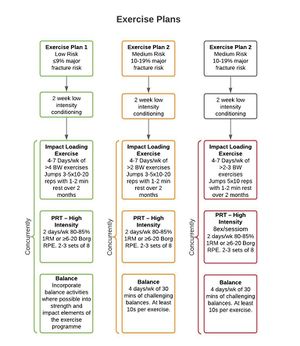Fracture Risk Assessment (FRAX) Tool: Difference between revisions
Carin Hunter (talk | contribs) No edit summary |
Carin Hunter (talk | contribs) No edit summary |
||
| Line 34: | Line 34: | ||
== FRAX Score Interpretation == | == FRAX Score Interpretation == | ||
After results have been calculated, you will see a "red box score". This shows the BMI and the 10-year probability of a fracture{{#ev:youtube|6r02weQNPXU}} | After results have been calculated, you will see a "red box score". This shows the BMI and the 10-year probability of a fracture{{#ev:youtube|6r02weQNPXU}} | ||
<ref name=":0">https://melioguide.com/frax/</ref> | <ref name=":0">https://melioguide.com/frax/</ref> | ||
| Line 41: | Line 40: | ||
# Moderate Fracture Risk. | # Moderate Fracture Risk. | ||
# High Fracture Risk | # High Fracture Risk | ||
[[File:Osteoporosis exercise plan.jpg|thumb|center]] | |||
== How to Adjust the T-Score Result == | == How to Adjust the T-Score Result == | ||
The FRAX calculator is specific to populations and geographical locations. You may need to adjust your T-score for your patients particular demographic.The adjustment tool can be found online at the [http://courses.washington.edu/bonephys/opbmdtz.html University of Washington]<ref>http://courses.washington.edu/bonephys/opbmdtz.html</ref> website | The FRAX calculator is specific to populations and geographical locations. You may need to adjust your T-score for your patients particular demographic.The adjustment tool can be found online at the [http://courses.washington.edu/bonephys/opbmdtz.html University of Washington]<ref>http://courses.washington.edu/bonephys/opbmdtz.html</ref> website | ||
Revision as of 09:20, 26 January 2021
Original Editor - User Name
Top Contributors - Carin Hunter and Kim Jackson
Objective[edit | edit source]
FRAX is short for Fracture Risk Assessment Tool. Any clinician can use this calculator[1] to predict the probability of an osteoporotic fracture within ten years in a patient.
Intended Population[edit | edit source]
The FRAX calculator is used to to evaluate fracture risk of patients and can be used by a healthcare professional within their clinical decision making process to know what intervention to best recommend. These interventions could incorporate pharmaceutical referral, an exercise program or nutritional changes.
Method of Use[edit | edit source]
To use the FRAX calculator, go to the FRAX calculator[1] on the Sheffield University website,
Click on the dropdown "CALCULATION TOOL" in the top panel and select the continent and country.
There are 2 components to the calculation
- The place you were born
- The place you currently live
The most accurate picture of bone health is to work out both scores and conduct a comparison. The initial calculation will give an idea of the genetic component while the second figure will incorporate information on your bone health related to sun exposure and diet.
The following information is then required
- Age, date of birth, sex, weight and height
- Previous and parent fracture history
- Smoking status
- Glucocorticoid steroid usage history
- Rheumatoid arthritis
- Secondary osteoporosis
- Alcohol consumption
- Femoral neck bone mineral density (BMD)
The results can then be calculated
FRAX Score Interpretation[edit | edit source]
After results have been calculated, you will see a "red box score". This shows the BMI and the 10-year probability of a fracture
In Exercise for Better Bones[3], the cardiovascular (or weight bearing) exercise recommendations fall into three categories:
- Low Fracture Risk.
- Moderate Fracture Risk.
- High Fracture Risk
How to Adjust the T-Score Result[edit | edit source]
The FRAX calculator is specific to populations and geographical locations. You may need to adjust your T-score for your patients particular demographic.The adjustment tool can be found online at the University of Washington[4] website
After adjusting the T-score use the normalized T-score in the FRAX calculator to continue and get your FRAX score.
Margaret Martin, physical therapist, has created a video tutorial on how to convert the T-score to be more specific to your patient.
Limitations[edit | edit source]
- Medications are not considered. The FRAX calculator does not take into account the usage of medications that could affect bone health.
- Calcium, Vitamin D, Vitamin K levels not considered
Resources[edit | edit source]
FRAX ®Fracture Risk Assessment Tool developed by The University of Sheffield







